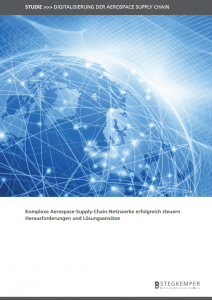Digitalization of the aerospace supply chain – the dream and the reality

70 percent of respondents in a new study on the digitalization of the aerospace supply chain say they are convinced that digitalization can be advanced only if all parties use the same system. But the reality proves to be different. More than 80 percent of the respondents confirm having to use multiple portals to communicate with customers – and this, even though approximately 90 percent of the respondents were convinced that the multitude of different portals undermined the positive effects of digitalization.
The continued digitalization of the supply chain across all levels – as the study also clearly found – is viewed as being one of the most important measures for mastering the future challenges in the aerospace industry.
Digitalization is primarily limited to the order process
The study unequivocally shows that a huge gap exists between the desire and the reality of collaboration in many areas within the supply chain. Indeed, collaboration between OEMs and Tier 1 suppliers is already digitalized to a large extent. But this primarily involves handling conventional order processes.
When considering other supplier-related processes, such as advance shipping notification, action tracking, or reconciliation of delivery reliability figures, a strikingly different picture becomes apparent. In these areas, many companies are looking for greater digitalization and processing within a shared tool – in terms of both the customer and supplier. And the earlier in the supply chain, the more often unstructured processes involving faxes, e-mails and Excel are encountered – coupled with an expressed desire for greater digitalization of supply chain processes.
However, in order to make digitalization a reality for even the initial levels of the supply chain, certain general conditions need to be met:
- Investments and current costs must be sustainable – in other words, lower than the savings that can be achieved with digitalization.
- A high level of data protection must be ensured.
- The principle of fair dealings must apply: All participants must benefit from the transparency and opportunities of the data analysis.
- One and the same solution must be used industry-wide.
Lack of interfaces and standards is seen as the biggest barrier
The three biggest obstacles for the integration of suppliers are considered to be the lack of preconfigured interfaces, insufficient standards for processes and the lack of standards for IT tools. As a first step, supplier associations are called on to support the definition of standards that apply throughout the industry. In a second step, these standards must be implemented and used by the industry – in particular the large OEMs and top-tier companies.
Although the call for standardized processes and IT tools is loud and clear, reality tells a very different story: Diversity is the dominating characteristic when it comes to both internal ERP systems and portals used: The need to take action is significant here. But so, too, is the opportunity to achieve major improvements and savings, if agreement could be reached on standards.
Would you like to learn more about the potential for further digitalization of the aerospace supply chain? Take a look at the complete study here: “Successfully Managing Complex Aerospace Supply Chain Networks”
The study was conducted as part of the “Initiative Supply Chain Excellence (SCE)” by Stegkemper GmbH in cooperation with SupplyOn AG. The results will be presented at the Aviation Forum in Hamburg (December 6 – 7, 2016).



